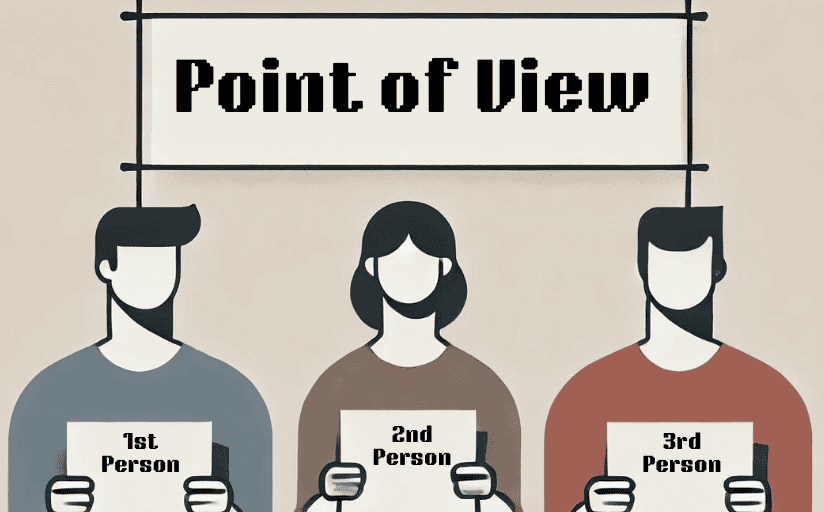Pop quiz, hotshot: What do The Rock, Bob Dole and Elmo have in common? They all regularly talk using third-person point of view.
Before he started scaling skyscrapers and feuding with Vin Diesel, The Rock frequently asked wrestling fans if they “could smell what The Rock [was] cooking.” When Bob Dole lost the New Hampshire primary in 1996, he famously promised voters that “You’re going to see the real Bob Dole out there from now on.” And Elmo — well, let’s just say that as the parent of a 3-year-old, I’ve heard that little pile of shag carpet screech “Elmo loves you!” so many times that IT HAUNTS MY DREAMS.
In speech, third person is a style choice used for effect. It’s called illeism, and it’s often a sign of a bloated ego. (I see you, Elmo.) But what is third-person point of view used for in writing — and how do you use it well?

What Is Third-Person Point of View?
Third-person point of view uses a narrator to explain what’s happening, whether that’s a sports reporter recapping the events of last night’s Knicks game or Holden Caulfield calling everybody a bunch of lousy phonies in “The Catcher in the Rye.” Writing that employs a third-person point of view uses third-person pronouns such as “she” and “her” or “they” and “their.”
Third-Person POV
Here’s a quick example of a sentence that fits our third-person point-of-view definition:
Dan had to sell his Super Bowl ticket because he already promised his niece that he’d attend her kazoo recital.
Notice that, in addition to calling Dan by name, the sentence also employs the third-person pronouns “he” and “his.”
First-Person POV
For contrast, here’s that same depressing sentence shifted into first person point of view, which explains what’s happening from the author’s perspective.
I had to sell my Super Bowl ticket because I already promised my niece that I’d attend her kazoo recital.
Here, the pronouns change from “he” and “his” to “I” and “my.” For better or worse, the first-person point of view gives you a glimpse into the writer’s head. It takes readers straight to the source, and it’s often used in fiction and opinion pieces. Memoirs and autobiographies are written in first person, too.
Second-Person POV
Finally, let’s switch things up one last time so you can see what this example looks like using second-person point of view, which uses the point of view of the person being addressed, aka you:
You have to sell your Super Bowl ticket because you already promised your niece that you’d attend her kazoo recital.
Looks kind of weird, right? If points of view were Marvel’s X-Men, second-person point of view would be Angel. It’s useful in specific situations, such as when you’re writing directions or perhaps a process analysis essay, but most of the time, you’d be best served by calling on another, more versatile member of the team.
You know, one that isn’t just a dude with bird wings.
Of the three types of point of view, third-person point of view is the most popular. It’s versatile enough to be used for both fiction and nonfiction writing. It gives writers a lot of control. And it comes in two flavors: omniscient and limited.
Third-Person Point of View Words List
If you see the following third-person pronouns, you’re likely reading the third-person POV.
| he | she | they | it |
| him | her | them | its |
| his | hers | their | itself |
| himself | herself | theirs | |
| themselves | |||
What’s the Difference Between Third Person Omniscient and Third-Person Limited Point of View?
You may have heard on the street that third-person point of view comes in two strains: omniscient and limited. You also just read it, like, two sentences ago. Either way, the rumors are true. Here’s how to tell these two forms of third-person point of view apart.

1. Third-Person Omniscient Point of View
If you’ve ever played a video game in God Mode — where every item, weapon and location is automatically unlocked for you — then you have a good idea of what third-person omniscient point of view is like. (And if, like me, you’re a freelancer, you probably play a lot of games.)
When you utilize third-person omniscient point of view, the narrator knows everything. He or she can be everywhere and see or hear everything — including what’s going on inside the characters’ heads. Nothing is off-limits.
Typically, this type of narrator stays objective. In nonfiction, he or she is expected to always stay objective. In fiction, too, the all-knowing narrator typically doesn’t make judgments and isn’t influenced by any sort of personal biases. Instead, he or she just reports on the action, like so:
Tonya ran out her front door and into the middle of Wedgewood Avenue, frantic. She whirled from right to left, scanning the area for her best friend. She felt a knot in the pit of her stomach. What if he was kidnapped? She quickly tried to dismiss the thought. After all, who would kidnap an elderly, 45-pound raccoon?
In this third-person point-of-view example, the narrator is positioned so that he or she can observe Tonya suddenly running out of her home and looking around. The narrator also knows what Tonya’s thinking and feeling. In short, the narrator is privy to information that no other character would have unless that other character was a telepathic thief who liked to steal trash pandas and gloat about it.
Many uber-famous works of fiction employ a third-person omniscient narrator, including “Little Women,” “Lord of the Flies,” “Beloved,” “The Hobbit,” and “Crazy Rich Asians.” That said, this POV is still not as popular as third-person limited.

2. Third Person Limited Point of View
As its name suggests, a third-person limited point of view utilizes a narrator whose access is limited to only what he or she can observe. Any insight this narrator has into other characters comes from observation or from what those characters say and do.
Limited POV
In other words, the third-person limited narrator can’t get inside anybody’s head and can’t report on events that he or she wasn’t actually there for. Let’s take a look at an example:
Standing at the top of the key, Gina clutched the basketball a little tighter. Her team was down by a single point, 52-51. She was wide open. She looked up at her parents in the stands. A bead of sweat trickled down her forehead as she turned her attention back to the clock on the scoreboard. It read “00:00” in bright red digits. The game was over. The Fightin’ Beluga Whales had lost.
In this limited third-person point-of-view example, we’re given only the facts of the situation. We don’t know why Gina clutched the ball a little tighter, for example, and we certainly don’t know why she didn’t actually shoot the ball. All we know is that we definitely don’t want Gina on our team the next time we play pick-up basketball.
Omniscient POV
To better illustrate the difference between limited and omniscient third-person point of view, let’s take that same passage and see what would happen if we had an all-knowing third-person omniscient narrator. It might look something like this:
Standing at the top of the key, Gina clutched the basketball a little tighter. Her team was down by a single point, 52-51, and she had a huge decision to make. She was wide open, but she’d also bet $14,000 against her own team. After all, that new Buick Rivieria wasn’t going to pay for itself. She looked up at her parents in the stands and wondered how she would explain herself to them. Could she claim temporary amnesia? Blame it on that pre-game burrito? What about demonic possession? A bead of sweat trickled down her forehead as she turned her attention back to the clock on the scoreboard. It read “00:00” in bright red digits. The game was over. The Fightin’ Beluga Whales had lost, and deep down, Gina knew that, Riviera or not, she had too.
In this omniscient third-person point of view example, the narrator is all up inside Gina’s head. From that vantage point, we learn that Gina’s harboring a big secret. She bet against her own team, and she feels lousy about it. She also has questionable taste in cars.
Limited POV Used for Reporting
Because we don’t get any of those insights with third-person limited, it’s prized for its lack of prejudices or opinions. Most reporting that you’ll find online or in print uses a third-person limited point of view, specifically because of its inherent objectivity:
The band thanked its fans and then retreated backstage after finishing its second song of the night, “Head Like an Oatmeal Cookie,” never to return. The crowd booed loudly. Many returned to the box office and demanded a refund.
Notice how there’s no judgment here, no assumption about why the crowd was so angry — even though it’s not difficult to imagine why. There’s no speculation about why the band bailed after its second track, either. Instead, a third-person limited point of view presents just the observable facts. (Think “show, not tell.”) In nonfiction that uses this point of view, the reader is expected to draw his or her own conclusions from the information presented. In fiction, both the reader and the other characters are left to do so.

What Are the Pros and Cons of Third-Person Omniscient Point of View?
Omniscient and limited third-person point of view each have their pros and cons. Some writing situations are better suited to one or the other, for example. Let’s dig into the omniscient third-person point of view first.
| Pros of Third-Person Omniscient POV | Cons of Third-Person Omniscient POV |
| It’s great for world-building. That’s why it’s seen most often in genre fiction. You can use your full arsenal of skills as a writer. In other words, you’re not limited by your characters’ skills and vocabulary. Providing a backstory is a cinch. There’s no need for flashbacks or tedious expository dialogue; you can just tell the reader directly what they missed or otherwise need to know. | Aside from works of fantasy, science fiction and horror, most contemporary literature shies away from third-person omniscient. Getting inside every character’s head can confuse readers or overwhelm them. It creates distance from the action. By pausing the story’s momentum to delve inside the characters’ minds or otherwise explain things, you can take the reader out of the narrative completely. |
What Are the Pros and Cons of Third-Person Limited Point of View?
Now let’s check out the third-person limited point of view’s advantages and disadvantages:
| Pros of Third-Person Limited POV | Cons of Third-Person Limited POV |
| You can switch between characters’ points of view. It adds a little mystery. If a character isn’t there when a big plot point happens, then you can keep it a secret from them — and your audience. It’s dynamic. In contrast, using first-person can get very “same-y” thanks to its repeated use of “I.” (And, as explained earlier, second-person, which relies heavily on “you,” is almost never the best call.) It’s popular. Most fiction uses this point of view, as does expository writing. It gives you more descriptive control. You can decide how close the audience gets to each character by what you choose to reveal. | If you switch between characters’ points of view too often, it can cause readers’ heads to spin. It’s easier to accidentally create plot holes — particularly if you have several characters or a complex narrative — by accidentally letting a character know something that, logically, he or she shouldn’t. It can lead to pronoun overload. When you have to drop so many third-person point-of-view words, it’s easy to lose track of which “she” is which, for example. It’s hard to describe what people look like unless you throw them in front of a mirror or make their appearance part of a conversation. It may cause you to use too many adverbs because you can’t access the characters’ inner thoughts. For example: “I made a reservation at Olive Garden,” Nathan said dejectedly. “My missing and obese pet raccoon used to love Olive Garden,” Tonya said wistfully. |

Versatility Is the Key
Whether you opt for omniscient or limited, a third-person point of view is a versatile mode of writing. You can use it to maintain your objectivity throughout essays and articles, to create thrilling action and chilling suspense, or to detail the inner turmoil of a 400-year-old spaghetti wizard.
Are you a third-person devotee? Got any tips for keeping your point of view consistent? Let us know in the comments below!


Leave a Reply